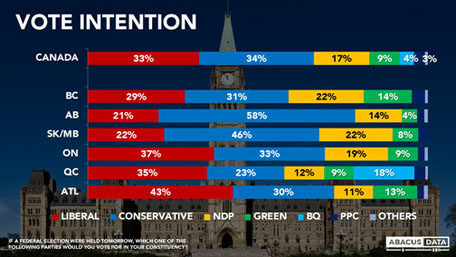How about Abacus Data’s latest thoughts on Canadian federal election October 21, 2019 : “A Tale of Two (Or More) Races”?
Sep 6th, 2019 | By Randall White | Category: In Brief
Bruce Anderson and David Coletto at Abacus Data have come up with (I think) an especially helpful and interesting take on the October 21 Canadian federal election, in reporting on their latest “national survey of 4,549 Canadians, completed on August 28.” (The Anderson and Coletto report is dated September 5.)
They start by noting that, Canada-wide : “If an election were held at the time of the survey, the Conservatives (34%) and Liberals (33%) would capture the same amount of popular support, followed by the NDP at 17%, the Greens at 9%, and the BQ at 4%.”

This is broadly consistent with recent polling results from other sources. Éric Grenier’s latest CBC Poll Tracker averages, eg (dated September 5 as well), give Conservatives 33.8%, Liberals 33.4%, NDP 13.5%, Greens 10.4%, BQ 4.4%, Peoples Party of Canada 2.9%, and Others 1.6%.
M. Grenier’s September 5 update also projects more seats for Liberals than Conservatives – but not quite a majority in the House. And a very close race between Liberals and Conservatives in popular vote, but with more seats to Liberals as a result of their more geographically efficient vote, is the current common folk wisdom about the October 21 Canadian election.
Anderson and Coletto’s latest Abacus Data ruminations, however, add two further refinements to this folk wisdom – that help explain why the Liberals are likely to win more seats (on current polling numbers at least).
The first refinement might be called the pure “Tale of Two Races” model. This notes that, broadly speaking again, there is a dramatic difference between the popular vote numbers in two different regions of the country.
As Anderson and Coletto put it : In the two turbulent Prairie energy provinces of “Alberta and Saskatchewan, the Conservatives have a massive 38-point lead over the Liberals.” But in the more laid-back “rest of the country, the Liberals hold a five-point lead” over the Conservatives.
Deconstructing the “rest of the country” gives the more refined “Or More” Model. In the words of Bruce Anderson and David Coletto : “Our latest numbers show the Liberals with a substantial lead (13 points) in Atlantic Canada, a 12 point lead in Quebec and a 4 point lead in Ontario. BC is a tie between the Liberals and Conservatives with the NDP and the Green parties together corralling 36% of the vote, considerably higher than their combined impact in any other region.”

This suggests a classic Canadian five-region model : (1) BC with Liberals and Conservatives tied (but a combined NDP/Green vote greater than either of the two leaders) ; (2) the Prairies with a commanding Conservative lead (and here we include Manitoba with Alberta and Saskatchewan, as implied by polls showing a Conservative victory in the Manitoba provincial election this coming Tuesday, September 10) ; (3) the most populous province of Ontario where the Liberals have a 4 point lead ; (4) the unique French-speaking majority province of Quebec where the Liberals have a 12 point lead, and (5) Atlantic Canada where Liberals have a 13 point lead.
Looked at through this kind of political lens, to summarize the current Canadian election race as a very close contest between Liberals and Conservatives, while apt enough in some ways, can be quite misleading in others. And somehow (again I think myself) to summarize the still long enough journey to October 21 as “A Tale of Two (Or More) Races” is just more interesting, and makes more sense.


